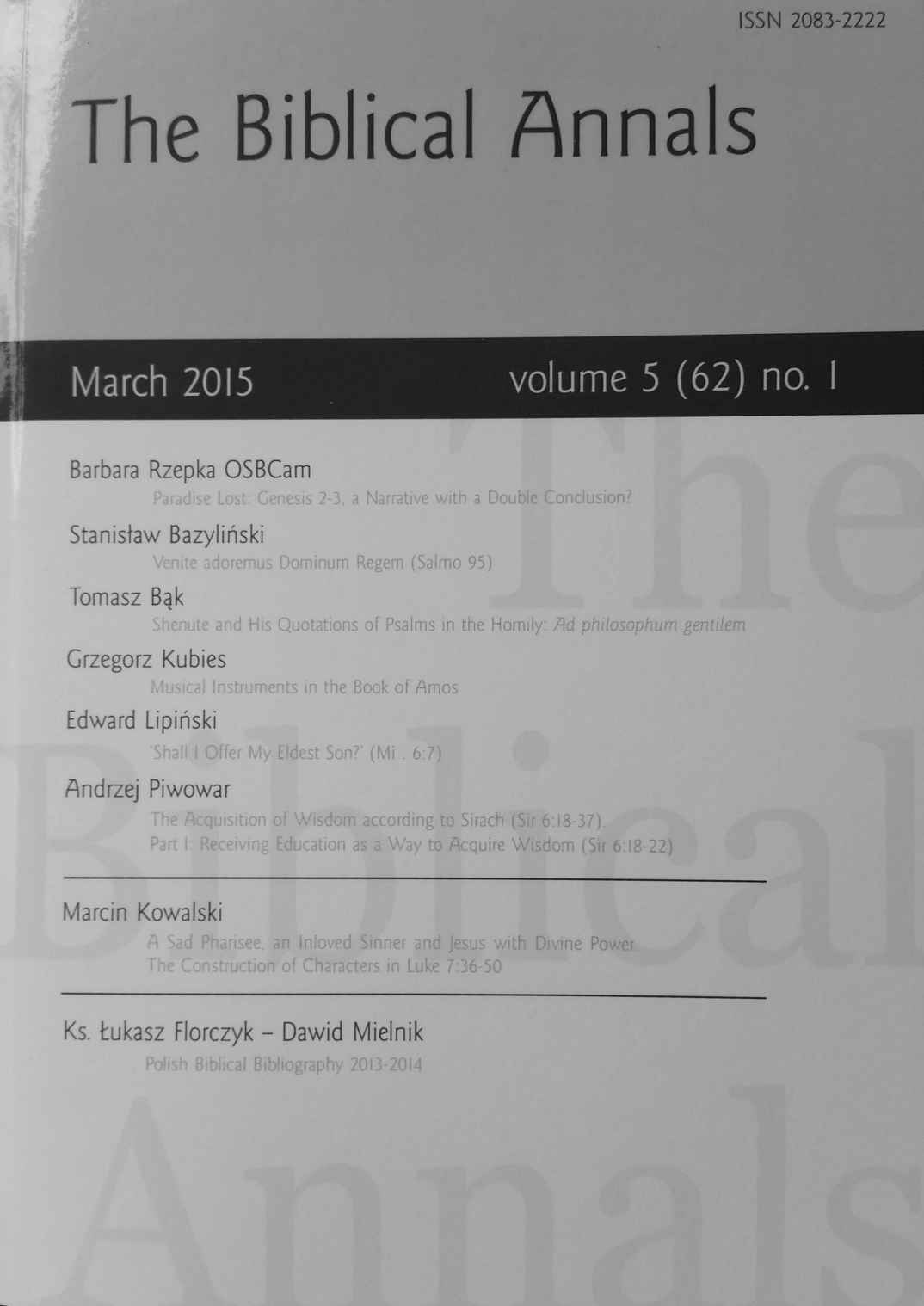
Bas Van Os, Psychological Analyses and the Historical Jesus.
New Ways to Explore Christian Origins (Library of New Testament Studies 432; London – New York: T&T Clark, 2012).
Book review
More...We kindly inform you that, as long as the subject affiliation of our 300.000+ articles is in progress, you might get unsufficient or no results on your third level or second level search. In this case, please broaden your search criteria.

New Ways to Explore Christian Origins (Library of New Testament Studies 432; London – New York: T&T Clark, 2012).
Book review
More...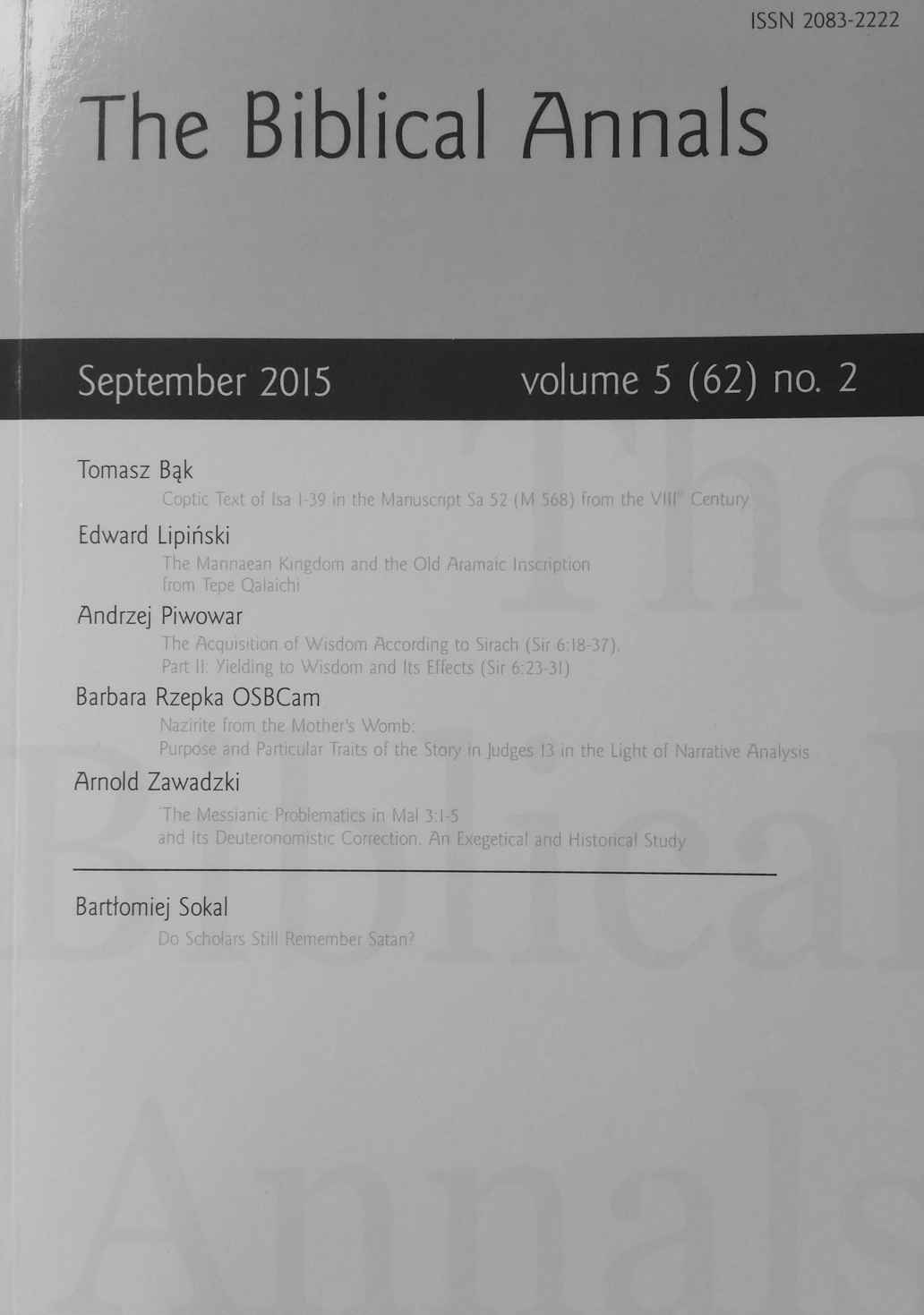
In this article I attempt to analyze a Coptic manuscript sa 52 (according to the nomenclature of K. Schüssler), from the collection of Pierpont Morgan Library. In this parchment codex we have almost the entire text of the Book of Isaiah in the Sahidic dialect of the Coptic language. The first part of this book is particularly important: the so-called Proto–Isaiah. One third of the text of Proto–Isaiah in Sahidic can be found only in our manuscript sa 52! The presentation and analysis of the codex sa 52 is divided in several parts. The first part contains a short history of our manuscript against the background of the whole Pierpont Morgan collection. In the second part there are some technical informations about our codex (its form, measurements, shape of the letters, manner of writing, etc.). The third part is dedicated to the Coptic text itself and its comparison with the Greek text of the Septuagint (according to the edition of J. Ziegler). In the last part – based on several examples – we try to answer the following question: how the Coptic text of sa 52 helps us in our interpretation of the Greek text of Proto–Isaia, especially when the text of Septuagint is difficult and unclear.
More...
It was first heard of a Mannaean kingdom from the Bible, in Jer. 51:27, andmore information became available only in the 19th-20th centuries with the publication of Neo-Assyrian and Urartaean tablets. An important piece coming from the kingdom itself was added to our sources by the publication of an Old Aramaic inscription from Tepe Qalaichi, south-east of Lake Urmia, probably the site of the Mannaean capital city, the Assyrianized name of which was Izirtu. The stele discovered in 1985 only preserves the final part of a longer text with imprecations against any king usurping the stele. Among the curses one finds an interesting reference to earthquakes. The rectified decipherment provides a running text, datable by palaeography to the later part of the 8th century B.C.:1) ‘Whoever would drag away this stele [and withhold it]2) in war or in peace, any kind of pestilence, [as]3) much as there is on the whole earth, may the gods impose on the [coun]try4) of that king. And may he be accursed to the gods and may he be accursed5) to Ḫaldi who is in Za‘ter. May seven cows6) nurse one calf and may it not be satiated. And may seven7) women bake in one oven and may they not fill8) it. And may vanish from his country the smoke of a furnace and the sound of9) a mill. And may his land be salted and may sway back and forth10) in it the crack of an earthquake. And that king who would [write]11) on this stele, may Hadad overturn his throne,12) as well as Ḫaldi. And during seven years may Hadad not send thunder13) in his country and may the entire curse of this stele smite him.’These curses contain no reference to encroachments of treaty clauses and they certainly cannot be regarded as the final section of a treaty. They rather close a eulogy of the ruling monarch, comparable to the Phoenician inscription of Kulamuwa. However, they seem to reveal a situation disturbed by internal competitions in the Mannaean kingdom, echoed in Neo-Assyrian texts of Sargon II. The oracle of Jer. 51:27 ff. has another background. It seems to have been originally directed against Assyria and to date from the time of Esarhaddon, when the Mannaeans with Urartu, the Scyths, and the Medes were opposing Assyria.
More...
Część II: Poddanie się mądrości i jego skutki (Syr 6,23-31)
The second part of Sir 6:18-37 (vv. 23-31) is a continuation of the pericope’s first part (vv. 18-22). Unlike the first part devoted to wisdom formation, however, the second part focuses on yielding to wisdom and its consequences. Sir 6:23-31 may be divided into three sections. The first one (vv. 23-25) is characterized by the deployment of images connected with servitude, the second one (vv. 26-28) employs the imagery of hunting, whilst the third section (vv. 29-31) returns to the slavery imagery of part one. The second part of Sir 6:18-37 thus has a concentric structure with vv. 6:26-28 as its centre. The fragments framing the central part evince the development of the sage’s thought: while section one (vv. 23-25) concentrates only on yielding to wisdom, of giving up on personal freedom and of the hardships the search for wisdom entails, section three in its allusions to section one depicts the glorious future awaiting those willing to make an effort to acquire wisdom.To acquire wisdom, it is necessary to yield to it fully, the way a slave does to his master. A failure to do so prevents one from the acquisition of wisdom. The second prerequisite is a persistent search for wisdom that should encompass all spheres of life. The sage also indicates the fruits the search for wisdom brings, which include rest, joy, and happiness that wisdom imparts to all those that attain it. In the concluding section Sirach presents the highest distinctions available to those who make an effort and acquire wisdom.
More...
The judge and savior of Israel in the “cycle of Samson” lacks the traits usually attributed to these figures: rather than deliver Israel, Samson is pursuing his own personal vendetta. In addition, the story of his birth (Judges 13) not only disrupts the habitual pattern in the stories of the various judges (the corruption of the Israelites, the description of the oppressor, then the cry of the people and finally the intervention God to raise up the savior), but it also creates a strong contrast with the entire cycle where his figure is underlined, over and above any religious component. This study stems from an attempt to discover the particular traits and purpose of such an unusual and extraordinary story as Jud 13. The work consists of five parts, and with regard to the exegetical method, the analysis of the text follows the synchronic criteria of narrative analysis; preliminary considerations, temporal indications, study of the performance of plots and purpose of the story. In conclusion, a few titles incorporating the most significant aspects of the story, which emerged during the analysis are presented.
More...
– studium egzegetyczno-historyczne.
Based on a detailed analysis of Mal 3:1-5, the article attempts to depict a specific function of the socially engaged messianic movement that opposes the incipient crisis of the Judean society in the 5th century BC. As evidenced by the editorial addition in Mal 3:1b-4, the internal discussion went on among the Judean leaders who were concerned about the growing discontent among the population and the subsequent emergence of the prophetic current that with its eschatological and subversive claims could undermine a slow and delicate process of the reconstruction of the country under the watchful and effective control of the Persians. The editorial addition in Mal 3:1-5 reveals the attempt to incorporate the original prophecy of Malachi in the process of extinguishing the embers of the social crisis.
More...

A Study in Light of the Evidence for the Role of “Founder-Figures” in the Hellenistic-Roman Period (WUNT I/292; Tübingen: Mohr Siebeck 2012).
Book review
More...
(Cambridge: Cambridge University Press, 2014).
Book review
More...
(Wiener Vorlesungen: Forschungen 5; Peter Lang: Frankfurt am Main et al., 2012).
Book review
More...
Lecture narrative du livre de Tobie (Le livre et le rouleau 46; Namur-Paris: Lessius 2014).
Book review
More...
La procedura del rîb come chiave interpretativa di Ez 16 (Analecta Biblica 207; Rome: Gregorian & Biblical Press 2015).
Book review
More...
Levi und die Leviten im Alten Testament (Beihefte zur Zeitschrift für die alttestamentliche Wissenschaft 448; Berlin – Boston: De Gruyter, 2014).
Book review
More...
Zum Gedanken einer Sonderstellung des Menschen im Alten Testament und in weiteren altorientalischen Quellen (ATANT 101; Zürich: TVZ Theologischer Verlag 2011).
Book review
More...
Rola kobiet w historii zbawienia” (KUL, 24 marca 2015)
Report from the Spring Bible Day “«Who Can Find a Virtuous Women?» (Prov 31:10).The Role of Women in the Salvation History” (KUL, Lublin, 24th of March 2015).
More...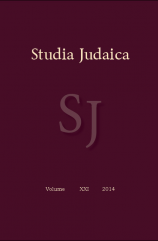
The study presents a historical account of the Kabbalistic literature from R. Isaac Sagi Nahor until Isaac Luria (12th – 15th centuries). The transition from orality to textuality and to printing was a very important process that the Kabbalistic sources underwent, transformation that is thoroughly examined in the study. The research work examines some aspects of early mysticism, followed by a survey of the Kabbalistic esotericism and by considerations on the emergence of the Christian Kabbalah.
More...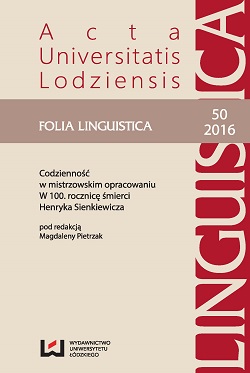
There has been presented a variety of religiously derived phrasemes and they have been analysed in order to determine a feature of style and a linguistic manner of creation of the world presented in the novel. In mental world of the characters of Trilogy, religion is the only worldview, and religiousness is the approach affecting all aspects of life. For instance, Swedish invaders are characterized as people wandering off religion, whereas Poles emphasise their „folk” religiousness, f.e. among gentry, soldiers, servants, etc.
More...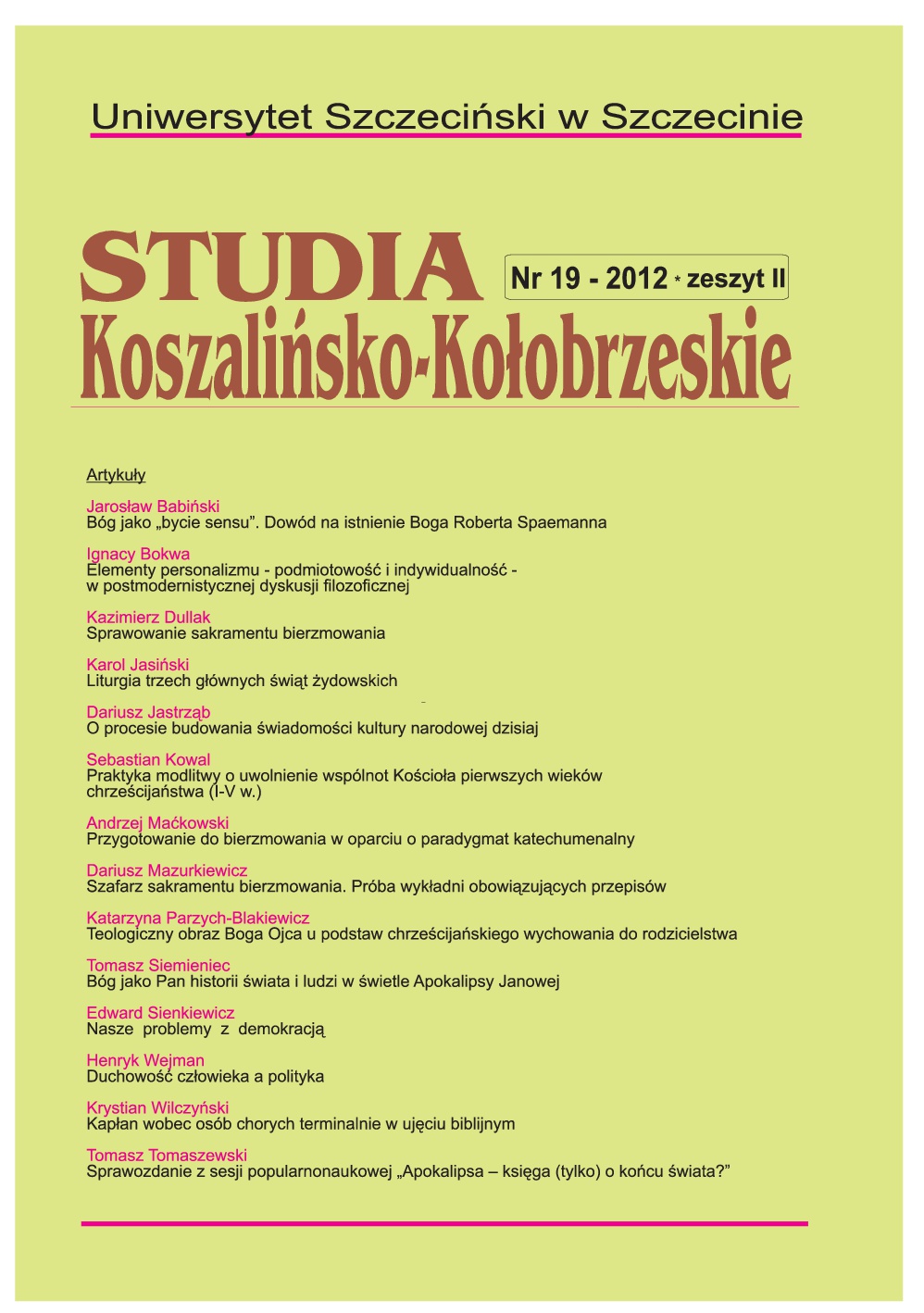
Conference Report: Tomasz Tomaszewski ̶̶ Sprawozdanie z sesji popularnonaukowej „Apokalipsa – księga (tylko) o końcu świata?”
More...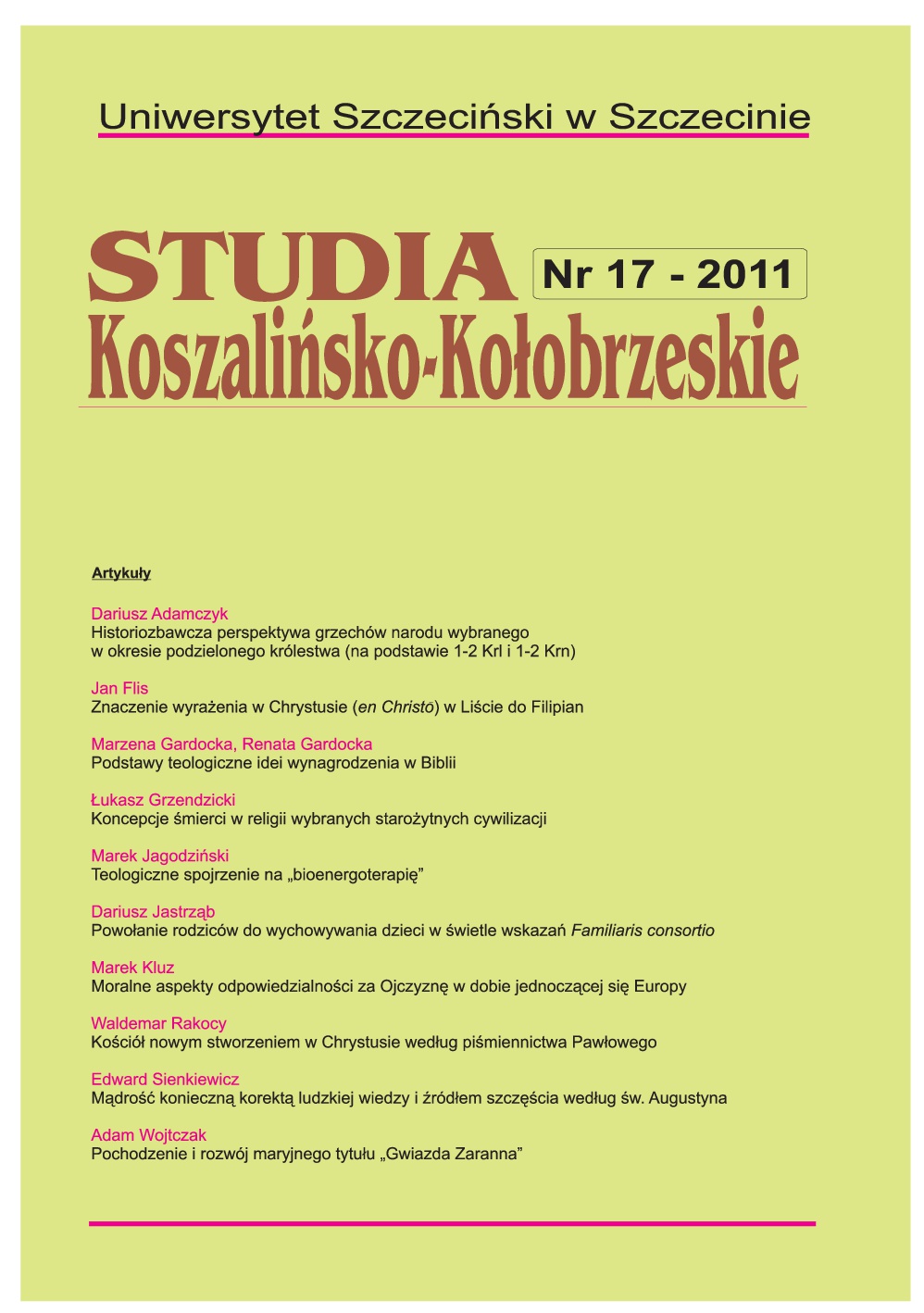
After the division of the kingdom into northern and southern states God was not worshiped in legitimate temple in the Israel kingdom but in sanctuaries of golden calf in the towns of Betel and Dan. The illegal cult also spread throughout the Judah kingdom as victims were sacrificed on hills and not in a temple. Those pagan cults were practiced in both kingdoms. Even kings, who were superiors of the cult, set a bad example in this regard. The significant sin was more confidence to external signs of the cult than a moral procedure line in accordance with Yahweh’s law in this period. According to 1-2 Kings and 1-2 Chronicles, the sinful behavior of chosen nation brought, at first on Israel and next on Judah, a cleansing punishment of displacement and slavery.
More...
The meaning of “bioenergy therapy” is very contentious. It is also very different valued – as total negative or total positive. As a phenomenon “bioenergy therapy” is very difficult to estimate, but real problems are connected with her interpretations, because they are often loaded with pseudo-religion, pseudo-philosophy or pseudoscience. In the face of danger to link such parapsychological phenomenon with occultism or magic exists also a big danger of demonic using and interpretation. Theology has the task to judge critically from their own view “bioenergy therapy” and to show soberly positive possibilities of such therapy and risks connected with her.
More...